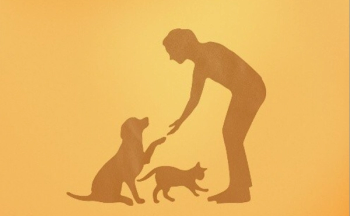
Canine patient survives chylothorax
Wolfie, a shepherd -lab mix, was diagnosed with the rare and life-threatening condition after presenting to veterinary clinics for trouble breathing and lack of appetite
In the spring of 2022, a stray canine walked into the yard of Curt and Caroline Putter of Hayden, Idaho and since they are dog lovers, they welcomed the stray into their home with their other 2 dogs and has called the Potter’s house his home ever since. Fast forward to July 2024 and the couple began to realize Wolfie was having difficult breathing and soon after began refusing food, even his favorite, confirming that something was not right with Wolfie. They brought him to veterinary clinics across north Idaho and eastern Washington, had a brief scare with a potential terminal cancer diagnosis, but later discovered Wolfie was suffering from chylothorax.
Despite the relief the Potters felt when they learned he did not have cancer, chylothorax can still be fatal, with most veterinary clinics not having the resources needed to handle the complex condition. Chylothorax is caused by an abnormal tangle of lymph vessels and leakage of lymphatic fluid in the patient’s chest cavity. According to a release from Washington State University,1 the leakage can make it extremely difficult to breathe and posed a risk of damage to his heart and lungs that is irreversible.
“Dogs that have this disease, they have what looks like a worm’s nest of lymph vessels, which is not normal. There should just be one or two ducts,” explained Boel A. Fransson, DVM, PhD, DACVS, in the release.1
After being told that their best option for Wolfie to get treatment is at Washington State University Teaching Hospital, they brought him into Fransson and the team at the hospital. Fransson reviewed Wolfie on the monitor screen and was able to see real-time images detailing the intricacies of his thoracic system. She then injected a special dye into Wolfie and watched as traces of his thoracic duct began to turn green as the dye spread.1
Chylothorax can be treated successfully with a procedure known as thoracic duct ligation, which is usually performed as an open surgery. In Wolfie’s case, the team was able to perform the surgery minimally invasive using a thoracoscopy for a higher rate of success and quicker recovery times. Although its rates of success are higher and recover is quicker, this procedure is not available everywhere due to the high level of experience and skill required from the surgeon as well as technology not being available at most facilities.
A week after his symptoms began, Woflie’s surgery was scheduled, and the team began prepping him by injecting fluorescent dye that moved rapidly through lymphatics into his chest to highlight the thoracic duct. Wolfie’s surgery team, consisting of Fransson, Peter Welsh, DVM, a surgery resident, and Thomas LeClair, a 4th year veterinary student, was also able to utilize a recently acquired near-infrared imaging system that was used to highlight the dye, This provided assistance to Fransson to precisely locate the leaking ducts, this were then closed with metal clips guided through the incisions made in the chest. During the 3-hour surgery, the team completed the procedure by removing Wolfie’s pericardium because in some cases, the leaking lymphatic fluid can cause the pericardium to thicken and constrict the heart.
Success rates for the alleviation of the diseases in both canine and feline patients is 40-60%. If surgical methods failed to fix chylothorax, alternative techniques can be discussed to attempt to prevent the accumulation of chyle, which are small molecules of fat that appear milky, in the thorax.2
The surgery was successful and after a few days in the intensive care unit, Wolfie was given the okay to go home to his family, who shared that he was recovered well and is back to his normal self.
References
- Rokyta D. WSU surgeons save dog battling rare condition. WSU Insider. Published November 7, 2024. Accessed November 12, 2024.
https://news.wsu.edu/news/2024/11/07/wsu-surgeons-save-dog-battling-rare-condition/ - American College of Veterinary Surgeons. Chylothorax. American College of Veterinary Surgeons. Accessed November 12, 2024.
https://www.acvs.org/small-animal/chylothorax/
Newsletter
From exam room tips to practice management insights, get trusted veterinary news delivered straight to your inbox—subscribe to dvm360.






